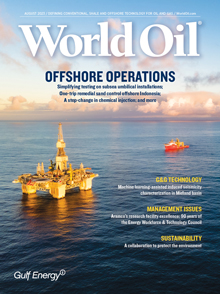Issue: August 2023
Special focus: Offshore operations
An automated cable monitoring system for testing subsea electrical assets is an efficient tool used in fault-finding and construction campaigns. It is fast and relatively simple to deploy, compared to downlines or platform-led testing. The technology delivers accurate data on the health of subsea assets.
Increased sand production in existing wells remains a challenge that forces operators to perform corrective work. An intervention-based remedial sand control system can be installed through tubing and combine sand clean-out as part of the installation process. Once installed, the tool requires no further intervention and is easily retrievable.
It is critical that chemical injection valves are reliable and have the flexibility to adapt to challenging downhole conditions. An innovative service provider is helping move the industry forward with the development and installation of the world's first API 19CI-qualified fall-through protection, non-return retrievable CIV.
A water management and risk prevention company provides a detailed overview of offshore water management and the impact its innovative cleaning techniques have in optimizing potable water operations and water supply.
Riserless casing drilling technology in the deepwater top hole interval can provide effective mitigation and isolation of deepwater shallow hazards. This shift in deepwater well construction allows deepwater riserless casing setting depths, based on prevailing pore pressure and fracture gradients, as opposed to the established strategy of “top setting” shallow hazards.
A new line of standardized manifolds strives to optimize costs, minimize carbon emissions and maximize performance in subsea operations with some certainty, all the while balancing the three legs of the energy “Trilemma.”
Global offshore decommissioning work continues at pace, with a significant portion occurring on the UKCS. Meanwhile, technical advances related to decommissioning continue, as well.
Features
A hybrid geophysical method enables engineers to understand the relationship between saltwater injection in the Ellenburger formation of West Texas and associated earthquake activity. The innovative combination of technologies provides operators with a reliable earthquake probability map to guide planning of injection wells and schedules to avoid environmental issues.
Understanding and fostering cohesion among stakeholders within the energy industry is a challenging but important endeavor, as the Energy Workforce and Technology Council celebrates 90 years of industry engagement.
As the research arm of Aramco, Exploration and Petroleum Engineering Advanced Research Center (EXPEC ARC) has accomplished much in its 17-year history, rising to new heights of technological innovation and achievement. The future heralds even greater contributions to global energy technology.
MicroSeismic’s passive seismic imaging technologies have been combined with EverAware’s IoT monitoring and data analytics capabilities to provide industry with a turnkey solution addressing key surface and subsurface MRV requirements, as per EPA’s Rule 40.
The oil and gas industry is under mounting pressure to enhance productivity,
efficiency and sustainability—all while reducing emissions. A laboratory information
management system is helping oil and gas companies achieve this, while providing
new opportunities to streamline productivity by enabling advanced digital solutions.
Technology is transforming every area of the oil and gas industry. To maximize the myriad benefits of digital transformation, it’s essential that companies commit to modernizing legacy systems and integrating new technologies.
Columns
Data show state of U.S. oil production remains steady
Are the days of sand proppant numbered?
Norway's offshore: Moving on
Water ownership and other news
Remanufacturing and the Circular Economy: Contributing to sustainability in the oil field
Digital collaboration
Resources
Benchmark crude prices surged in July, as global demand reached near record highs, boosted by strong summer air travel, increased oil use in power generation and higher Chinese petrochemical activity.



